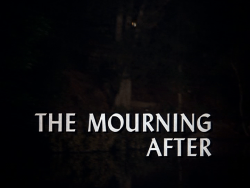The Mourning After (Quincy, M.E.)
| The Mourning After | ||||||||||||||||||||||||||||||||||||||
|---|---|---|---|---|---|---|---|---|---|---|---|---|---|---|---|---|---|---|---|---|---|---|---|---|---|---|---|---|---|---|---|---|---|---|---|---|---|---|

| ||||||||||||||||||||||||||||||||||||||
|
Episode Quote
"This wasn’t a pledge gone wrong—it was a death staged to look natural…" ~ Dr. Quincy, reflecting on autopsy findings contradicting hazing accident assumptions
Episode Overview
The Mourning After centers on the suspected drowning of college freshman Carey Stadler during a fraternity hazing ritual. Although initially ruled accidental, Quincy’s autopsy findings—no water in the lungs and ligature marks—point to foul play and cover‑up by fraternity peers and complicit authorities :contentReference[oaicite:1]{index=1}.
Table of Contents
Application of The QME Episode Laws
✅ **Law 1**: Quincy relentlessly seeks justice for a young victim dismissed as an accident.
✅ **Law 2**: The episode explores the ethical consequences of hazing, secrecy among peers, and institutional cover‑ups.
✅ **Law 3**: Sensitive portrayal of trauma and family grief avoids sensationalism, despite disturbing subject matter.
✅ **Law 4**: Scientific accuracy is central—autopsy and toxicology findings overturn superficial assumptions about drowning and accidental death.
Episode Synopsis
When freshman Carey Stadler is reported drowned after a hazing ritual, authorities conclude accidental drowning. Quincy, however, finds inconsistencies: no water in lungs, ligature marks on wrists, and timeline discrepancies. He guides family through grief counseling and helps the police and DA investigate more rigorously. Quincy determines that he was tied and forced into deeper waters away from campus, where he drowned. The fraternity’s subsequent cover‑up—relocating body to poolsite—aimed to mask culpability. Ultimately, Quincy’s forensic diligence ensures justice for Carey and accountability for those involved.
Plot Summary
Quincy is called in after the body of Carey Stadler is delivered following a fraternity initiation involving forced swimming. While others suggest alcohol‑induced misstep, Quincy notes no aquatic evidence—lungs are bone‑dry. Bruising and ligature marks on wrists point toward forced restraint. As the family grapples with grief, Quincy supports psychological closure and insists the case be pursued. With autopsy, timeline reconstruction, and ligand analysis, Quincy exposes a tragic hazing death covered up by relocating the body to mislead investigators. Law enforcement brings charges accordingly.
← S07E23 – "Deadly Protection" • The Mourning After (Season 7 Finale) Season 7 Overview: Full Episode List :contentReference[oaicite:2]{index=2}
Main Cast
- **Jack Klugman** as Dr. R. Quincy, M.E.
- **Robert Ito** as Sam Fujiyama
- **John S. Ragin** as Dr. Robert Asten, M.E.
- **Garry Walberg** as Lt. Monahan
Guest Cast
- **Timothy Patrick Murphy** as Nick Stadler (brother)
- **Carol Eve Rossen** as Brenna Stadler (Carey’s sister)
- **Guy Sartee** as Ted Yost (fraternity member)
- **James A. Watson Jr.** as Deputy DA Jim Barnes :contentReference[oaicite:3]{index=3}
Case File Summary
Victim: Carey Stadler (college freshman) Case #: College hazing death investigation, Branham College
Quincy’s forensic autopsy reveals drowning staged as accident, with efforts to relocate the body and suppress evidence. His findings prompt criminal investigation and family closure grounded in truth and accountability.
Additional Victims
- No secondary fatalities, but emotional harm to the Stadler family and moral injury from fraternity code.
Alleged Perpetrator(s)
- Fraternity organizers/members responsible for forced hazing
- Possible institutional reluctance to fully prosecute
Filming Locations and Exterior Footage
Standard production sets depicting coroner office, college campus, and lakeside scenes, likely filmed on Universal backlot in Los Angeles. No publicly documented on‑location shooting for this episode.
Forensic Science Insight
- Absence of water in Carey’s lungs belies drowning claim.
- Ligature marks on wrists indicate forced restraint prior to immersion.
- Timeline discrepancies between fraternity account and estimated time of death challenge initial narrative.
- Quincy facilitates grief counseling, recognizing psychological steps in post‑mortem family care :contentReference[oaicite:4]{index=4}.
Themes & Tropes
- Hazing Ritual Gone Wrong – fraternity conduct and escalation
- Cover‑Up and Disclosure – staged accident and relocation of body
- Grief Processing – family trauma and Quincy’s supportive role
- Forensics as Advocate – medical evidence confronting cultural norms
Reception & Ratings
The episode earned an IMDb user rating of approximately **7.2/10**, with reviewers noting its serious tone, thematic gravity, and emotional focus—some found pacing slow and therapy scenes heavy but appreciated the social relevance and forensic realism :contentReference[oaicite:5]{index=5}.
Trivia
- Quincy had to request exhumation to detect ligature marks post‑autopsy—a plot point criticized in viewer reviews. :contentReference[oaicite:6]{index=6}
- The episode addresses hazing—a social issue Quincy tackled with sensitivity, echoing broader themes of youth culture and institutional responsibility.
Cultural Impact
As a finale episode, it closes Season 7 with an uncompromising look at hazing culture and institutional prevention failures. It exemplifies Quincy’s blend of forensic authority and advocacy, anticipating later dramas that explore youth deaths and systemic accountability.
See Also
- Quincy, M.E.
- List of Quincy, M.E. episodes
- Hazings in popular culture
- Forensic pathology in television
External Links
- [IMDb: The Mourning After](https://www.imdb.com/title/tt0681861/ "IMDb – The Mourning After")
